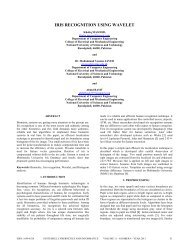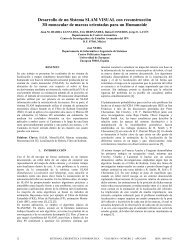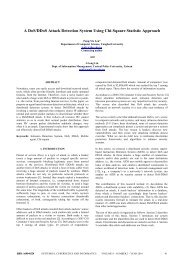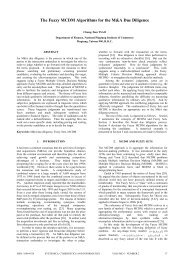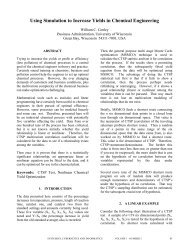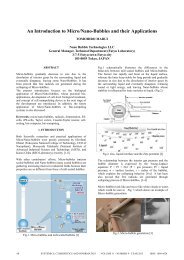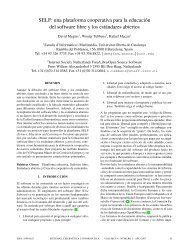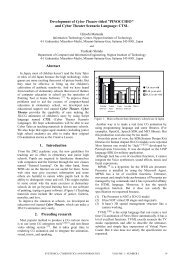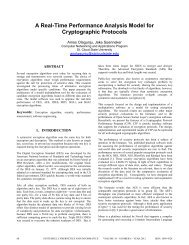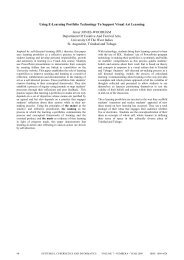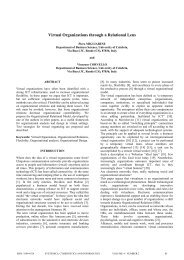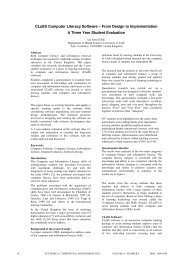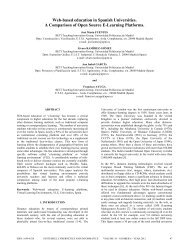E-Government & Public Service Delivery: Enabling ICT to put ...
E-Government & Public Service Delivery: Enabling ICT to put ...
E-Government & Public Service Delivery: Enabling ICT to put ...
Create successful ePaper yourself
Turn your PDF publications into a flip-book with our unique Google optimized e-Paper software.
E-<strong>Government</strong> & <strong>Public</strong> <strong>Service</strong> <strong>Delivery</strong>: <strong>Enabling</strong> <strong>ICT</strong> <strong>to</strong> <strong>put</strong> “People First” – A<br />
Case Study from South Africa<br />
ABSTRACT<br />
The literature on the effectiveness of e-government in<br />
developing countries <strong>to</strong>wards improving public service<br />
delivery is littered with failure s<strong>to</strong>ries. Notwithstanding,<br />
the failures have not s<strong>to</strong>pped most governments in<br />
developing countries from increasingly turning <strong>to</strong> <strong>ICT</strong>,<br />
most notably internet based models, as the preferred<br />
channel for citizen-centered service delivery. This paper<br />
investigated e-government within the developing country<br />
context of South Africa. We used the interpretive<br />
paradigm primarily because we wanted <strong>to</strong> increase our<br />
understanding of the phenomenon of e-government for<br />
public service delivery within the local South African<br />
context. The investigation focused on one of the<br />
governments primary service delivery programmes –<br />
social grants. The analysis of findings suggest that egovernment<br />
in South Africa is not aligned <strong>to</strong> the service<br />
delivery philosophy, Batho Pele, and is hence not<br />
effective in delivering on the public service delivery<br />
mandate. Batho Pele which literally means “people first”<br />
is similar <strong>to</strong> the UNDP Human Development Indica<strong>to</strong>rs<br />
for development. The contribution of this research can be<br />
extended <strong>to</strong> both practice and IS theory. The research<br />
highlights the need for <strong>ICT</strong>4D, particularly e-government<br />
in developing contexts, <strong>to</strong> firstly be aligned <strong>to</strong> the current<br />
over-arching government philosophies if they are <strong>to</strong> have<br />
any effective impact on service delivery. The practical<br />
contribution of the research is a possible framework that<br />
could be used <strong>to</strong> align e-government in South Africa <strong>to</strong><br />
the government philosophy of service delivery.<br />
Keywords: E-government, <strong>Public</strong> <strong>Service</strong> <strong>Delivery</strong>,<br />
Batho Pele, <strong>ICT</strong>4D<br />
1. INTRODUCTION<br />
Batho Pele & <strong>Public</strong> <strong>Service</strong> <strong>Delivery</strong> in South Africa<br />
Batho Pele is South Africa’s constitutionally mandated<br />
public service delivery philosophy. The essence of Batho<br />
Pele is <strong>to</strong> transform the way of working of public servants<br />
from the lethargic style which was typical of the previous<br />
unpopular apartheid system of government in<strong>to</strong> an<br />
inclusive and participa<strong>to</strong>ry model where citizens can hold<br />
public servants accountable for the levels of service the<br />
receive from government [1-3]. The expected<br />
transformation in service delivery is better comprehended<br />
on the reflection that South Africa has only been a<br />
Wikus VISSER<br />
Department of Informatics, University of Pre<strong>to</strong>ria<br />
Pre<strong>to</strong>ria, Gauteng, South Africa<br />
and<br />
Hossana TWINOMURINZI<br />
Department of Informatics, University of Pre<strong>to</strong>ria<br />
Pre<strong>to</strong>ria, Gauteng, South Africa<br />
democratic country since 1994. 14 years is arguably a<br />
short time <strong>to</strong> expect transformation.<br />
The path of service delivery transformation formally<br />
began in 1995 with the release of the White Paper on the<br />
Transformation of <strong>Public</strong> <strong>Service</strong> [4]. The WPTPS<br />
established the institutional framework that could guide<br />
the introduction of new policies and the implementation<br />
of the new constitutional mandates. It was shortly<br />
followed in 1997 by the White Paper on Transforming<br />
<strong>Public</strong> <strong>Service</strong> <strong>Delivery</strong>, labeled as the Batho Pele White<br />
Paper [5]. The Batho Pele White Paper specifically aimed<br />
at promoting integrated and seamless public service<br />
delivery. These two policy papers set the stage <strong>to</strong>wards<br />
radically transforming the previously dysfunctional<br />
apartheid system. It is from the latter white paper that the<br />
Batho Pele philosophy of service delivery was adopted.<br />
Batho Pele advocates nine principles <strong>to</strong> guide public<br />
servants; consultation with citizens, setting service<br />
standards, increasing access <strong>to</strong> information, ensuring<br />
courtesy, providing information, openness and<br />
transparency, redress and value for money.<br />
On the other hand South Africa, through its Center of<br />
<strong>Public</strong> <strong>Service</strong> Innovation (CPSI), places significant<br />
importance <strong>to</strong> initiatives <strong>to</strong> transform government’s way<br />
of working through <strong>ICT</strong> – a notion commonly known as<br />
e-government / e-governance.<br />
E-<strong>Government</strong> & E-Governance<br />
The terms e-government and e-governance are often used<br />
<strong>to</strong> describe a government’s use of Information and<br />
Communication Technology (<strong>ICT</strong>) <strong>to</strong> render services <strong>to</strong><br />
its citizens. Within the research community there is a<br />
debate on the correct use the two terms.<br />
E-governance can be defined as “the use of emerging<br />
information and communication technologies <strong>to</strong> facilitate<br />
the processes of government and public administration”<br />
[6]E-government can be defined as “the use of<br />
information technology <strong>to</strong> support government<br />
operations, engage citizens, and provide government<br />
services” [7].
While the e-governance definition focuses on the use of<br />
<strong>ICT</strong> <strong>to</strong> assist in the administration or management of<br />
government, the e-government definition focuses on the<br />
use of <strong>ICT</strong> <strong>to</strong> provide services in support of government<br />
operations. While there is still no definitive outcome <strong>to</strong><br />
for the use of the terms, the term e-government will be<br />
used as per the second definition, thus focusing on<br />
government or public services through the use of <strong>ICT</strong>.<br />
The dominant models for e-government find their roots in<br />
public management models and e-business models. While<br />
researchers of e-government differ on the rights,<br />
privileges and obligations of clients, cus<strong>to</strong>mers and<br />
citizens [8, 9], they generally concur that e-government<br />
moves through stages <strong>to</strong> reach maturity.<br />
Notwithstanding, the successful initiatives are hard <strong>to</strong><br />
come by. This realization led <strong>to</strong> the very important and<br />
underlying concern: are government <strong>ICT</strong> technological<br />
innovations adhering <strong>to</strong> the principles of ‘people first’, so<br />
<strong>to</strong> say, are the government <strong>ICT</strong> technological innovations<br />
enabling the improvement of service delivery in South<br />
Africa?<br />
This research sought <strong>to</strong> acquire an understanding <strong>to</strong> this<br />
concern by focusing attention on the government agency<br />
responsible for one of the key service delivery programs –<br />
the South African Social Security Agency, SASSA.<br />
The remainder of the paper is formatted as follows; the<br />
next section discusses the research approach and setting<br />
where the justification for using an interpretive research<br />
approach is made as well as the setting where the<br />
investigation was carried out, SASSA. The next section<br />
discusses the findings of the research. It is followed by the<br />
implication of the research <strong>to</strong> IS theory and practice<br />
before the final section where conclusions are drawn.<br />
2. RESEARCH APPROACH<br />
Research Philosophy<br />
IS research and IS practice are worlds apart which brings<br />
in<strong>to</strong> question the relevance in IS research <strong>to</strong> inform IS<br />
practice and vice-versa [10]. Benbasat and Zmud [10]<br />
define relevant research as, “one that is potentially useful<br />
for, as well as accessible by, its intended audience”<br />
Benbasat and Zmud (p.12). There are three generally<br />
over-arching means of inquiry <strong>to</strong> establish what<br />
constitutes relevant research; positivism, interpretivism<br />
and critical theory [11]. Each of these paradigms is based<br />
on some underlying on<strong>to</strong>logical and epistemological<br />
assumptions about what constitutes relevant research [12].<br />
The choice of research paradigm as such has considerable<br />
implications on the findings, the interpretation and the<br />
analysis of the findings, and the resultant inferences. This<br />
realization amplifies the significance of reflectively and<br />
diligently selecting an appropriate means of enquiry <strong>to</strong><br />
conduct research.<br />
The underlying philosophical paradigm that will be used<br />
during the research will be that of Interpretivism. The<br />
reasoning behind this is <strong>to</strong> create a greater understanding<br />
of the phenomenon of e-government and public service<br />
delivery through the interpretation that humans assign<br />
[13]. The central on<strong>to</strong>logical focus in interpretivism is the<br />
relationship between the researcher and the phenomenon<br />
being studied [14]. Reality is a result of individual<br />
subjective interpretations and/or of inter-subjective<br />
constructions shared between individuals.<br />
Epistemologically, facts and values cannot be separated<br />
and knowledge is viewed as ideological serving the<br />
interests of particular social groups [15]. The investigative<br />
processes employed in interpretivism can either be<br />
qualitative or quantitative with the method being<br />
determined by the phenomena under investigation. Good<br />
interpretive research is therefore dependent on bringing<br />
out as full an understanding as possible of the<br />
phenomenon while addressing any personal bias that the<br />
researcher may bring in<strong>to</strong> the study [16, 17].<br />
This research adopted the criteria for conducting and<br />
evaluating interpretive research proposed by Klein and<br />
Myers [13]. Their criteria are based on the principle of the<br />
Hermeneutic Circle which suggests that a deeper<br />
understanding of a text (e-government) in relation <strong>to</strong> its<br />
context (Batho Pele & <strong>Public</strong> <strong>Service</strong> delivery) can only<br />
take place through a back and forth movement of renewed<br />
understandings.<br />
A case study of a government department, the South<br />
African Social Security Agency (SASSA), was adopted <strong>to</strong><br />
investigate the phenomenon of e-government will be<br />
studied in the context of Batho Pele [18]. Since each egovernment<br />
service is measured against the same<br />
principles defined in Batho Pele, Lee [19] suggests that<br />
generalizations from the case study can be drawn from the<br />
unit of analysis and its applicability <strong>to</strong> other government<br />
units. Data was collected through structured face-<strong>to</strong>-face<br />
and telephonic interviews with people involved in<br />
delivering an <strong>ICT</strong> system <strong>to</strong> the business units of the<br />
South African Social Security Agency (SASSA). The next<br />
section gives an overview of SASSA.<br />
The Case Study<br />
SASSA was established as an extension of government<br />
delivery arm that administers the delivery of social grants<br />
<strong>to</strong> the poorest of the poor in South Africa [20]. SASSA’s<br />
vision and mission is aligned with several Batho Pele<br />
principles, namely <strong>to</strong> “provide world class social security<br />
services” (<strong>Service</strong> Standards principle) and <strong>to</strong> deliver<br />
“innovative, cost effective and efficient services <strong>to</strong><br />
individuals” (Value for Money principle), “their families<br />
and community groups via multi-and easy access channels<br />
using modern technology” (Increasing Access principle)<br />
[21]. In essence the service delivery of social grants <strong>to</strong><br />
beneficiaries is the sole mandate of SASSA. This<br />
research focused on SASSA’s use of <strong>ICT</strong> as a service<br />
delivery enabler <strong>to</strong> achieve its vision and mission, and<br />
ultimately comply with Batho Pele principles.
Role of the Researcher<br />
The selection of the case was based on the thrownness<br />
[22] of the first author as a government agency employee<br />
working on a project <strong>to</strong> deliver a focused <strong>ICT</strong> service <strong>to</strong><br />
SASSA. This places the researcher in the position <strong>to</strong> gain<br />
access <strong>to</strong> interviewees and system information. Approval<br />
from interviewees was of high importance, and was<br />
obtained by following professional and ethical pro<strong>to</strong>cols<br />
approved by the University.<br />
Research Design<br />
In order for the research <strong>to</strong> be effectively contextualized,<br />
the principles of Batho Pele which are aligned <strong>to</strong> SASSA<br />
were used as the source for the measurement criteria <strong>to</strong><br />
determine the impact of e-government initiatives as<br />
described next.<br />
Setting service standard: Batho Pele aims for<br />
government departments <strong>to</strong> benchmark the standard of<br />
delivering a service or product <strong>to</strong> the public. This will<br />
assist the public <strong>to</strong> measure the department’s services, and<br />
play an important role in service improvement plans. The<br />
aim of service standards would be <strong>to</strong> measure public<br />
satisfaction with the products or services being delivered.<br />
Relating this principle <strong>to</strong> <strong>ICT</strong> support, would imply if the<br />
government department or agency has specific<br />
measurable service standards. Questions during the<br />
interviews included probing as <strong>to</strong> how <strong>ICT</strong> assisted or<br />
improved the delivery of the product or service.<br />
Increasing access: Many South Africans do not<br />
have direct access <strong>to</strong> public services supplied by the South<br />
African government. Batho Pele aims <strong>to</strong> equally distribute<br />
those services <strong>to</strong> the public. Access <strong>to</strong> information and<br />
services empowers citizens and creates value for money,<br />
quality services. It reduces unnecessary expenditure for<br />
the citizens. Questions that can generally be answered<br />
during the interview can revolve around what <strong>ICT</strong><br />
initiatives are being used <strong>to</strong> increase the accessibility of<br />
the service or product and how accessible these initiatives<br />
are <strong>to</strong> communities who don’t have the required <strong>ICT</strong><br />
infrastructure. Another area <strong>to</strong> investigate would be in<br />
what ways this initiative would reduce unnecessary<br />
expenditure for the public.<br />
Providing information: Availability of<br />
information with regards <strong>to</strong> products and services should<br />
not only be at the service point, but should also strive <strong>to</strong><br />
increase the availability of products and services <strong>to</strong> the<br />
public who are far away from those service points (DPSA,<br />
2001c). The main area of focus would be <strong>to</strong> increase the<br />
availability of information <strong>to</strong> the public who are far away<br />
from service points. Questions that can be asked during<br />
interviews would be how <strong>ICT</strong> supports the provision of<br />
information as part of the service or product delivered <strong>to</strong><br />
the public, how accessible is this information as supplied<br />
by the e-government initiative <strong>to</strong> communities and how<br />
often is information updated <strong>to</strong> ensure correctness of<br />
information.<br />
Value for money: Improvements <strong>to</strong> service<br />
delivery should not come at a premium <strong>to</strong> the public.<br />
Incorrect information provided or processes reengineered<br />
could result in the public having <strong>to</strong> spend more time,<br />
effort or even money <strong>to</strong> receive a product or service.<br />
<strong>Service</strong> delivery improvement should strive <strong>to</strong> be done<br />
with the same amount of resources or even less. Egovernment<br />
should support the public <strong>to</strong> receive costeffective<br />
services and products. Questions during<br />
interviews could range from how e-government is<br />
ensuring that the public spends fewer resources <strong>to</strong> receive<br />
a product or service, <strong>to</strong> how it is improving the processes<br />
within government <strong>to</strong> render that service or product.<br />
Based on the criteria, a measurement matrix with a threepoint<br />
of assessment was derived as follows:<br />
Y: The initiative supports the principle<br />
N: The initiative does not support the principle<br />
P: The initiative partially supports the principle<br />
Table 1: The Measurement Matrix<br />
Batho Pele Principle <strong>Government</strong>’s<br />
<strong>ICT</strong> Use<br />
Measure<br />
Setting service standards Comments Y, P, N<br />
How is <strong>ICT</strong> assisting or<br />
improving in the delivery of the<br />
product or service?<br />
How is <strong>ICT</strong> being used <strong>to</strong><br />
measure service improvement?<br />
How is <strong>ICT</strong> being used <strong>to</strong><br />
measure public satisfaction?<br />
Increasing access Comments Y, P, N<br />
What <strong>ICT</strong> initiatives are being<br />
used <strong>to</strong> increase the<br />
accessibility of the service or<br />
product?<br />
How accessible is this <strong>ICT</strong><br />
initiatives <strong>to</strong> communities who<br />
don’t have <strong>ICT</strong> infrastructure?<br />
In what ways would this <strong>ICT</strong><br />
initiative reduce unnecessary<br />
expenditure for the public?<br />
Providing information Comments Y, P, N<br />
How does <strong>ICT</strong> improve the<br />
provisioning of information<br />
about products and services?<br />
How of accessibility of the<br />
information <strong>to</strong> communities<br />
Value for money Comments Y, P, N<br />
How is <strong>ICT</strong> supporting the<br />
public <strong>to</strong> spend fewer resources<br />
in obtaining the product or<br />
service?<br />
In what way is <strong>ICT</strong> supporting<br />
business process<br />
reengineering?
3. ANALYSIS & DISCUSSION OF FINDINGS<br />
The set of principles as proposed by Klein and Myers [13]<br />
were used as a point of departure <strong>to</strong> discuss the<br />
interpretations of the collected data.<br />
The principle of contextualization tries <strong>to</strong> highlight the<br />
meaning of the text, as different audiences could differ in<br />
their interpretation of the text. What is needed is <strong>to</strong><br />
establish the his<strong>to</strong>rical background of the text or subject,<br />
in order for interviewees and readers of the research <strong>to</strong><br />
interpret the text in the same manner. Thus it is needed for<br />
the researcher <strong>to</strong> consciously reestablish the<br />
understanding of Batho Pele, e-government and service<br />
delivery <strong>to</strong> the reader and the interviewees via its origins,<br />
definitions and related concepts.<br />
In this light the interview subjects were well habituated <strong>to</strong><br />
the meaning of service delivery and Batho Pele. The<br />
vision and mission of SASSA is founded on the principles<br />
of Batho Pele and the constitution of South Africa. The<br />
interviewees, being public servants, were also well<br />
informed of the service delivery principles as part of their<br />
induction at SASSA. In contrast, not all interviewees<br />
unders<strong>to</strong>od the definition of e-government. Only after<br />
explaining that the use of <strong>ICT</strong> <strong>to</strong> support government<br />
operations constitutes e-government, which includes the<br />
use of a transversal system like SOCPEN, were the<br />
participants able <strong>to</strong> contextualize e-government within<br />
SASSA.<br />
The principle of interaction between the researcher and<br />
the subjects places the research done in a social context,<br />
which explains that the subjects become interpreters<br />
themselves of the research subject. The interviewees will<br />
interpret what and how the research subject is presented <strong>to</strong><br />
them, and how that could possibly affect them, before<br />
responding <strong>to</strong> the interviewee. The researcher<br />
acknowledges that the relationship between the researcher<br />
and interviewee and the social interaction of how the<br />
interview questions were presented, could influence the<br />
responses from the interviewee. However, the principle of<br />
abstraction and generalization was used <strong>to</strong> generate<br />
factual themes throughout the interviews.<br />
The theoretical abstracts of Batho Pele and e-government<br />
were unders<strong>to</strong>od by the participants, as well as the context<br />
that these abstracts have within SASSA. Interviewees<br />
unders<strong>to</strong>od the foundation principles of service delivery.<br />
This could be ascribed <strong>to</strong> the fact that many of their<br />
performance contracts are linked <strong>to</strong> improving public<br />
service delivery. <strong>ICT</strong> is used as a business support <strong>to</strong>ol,<br />
and since the business of government is <strong>to</strong> deliver a public<br />
service, <strong>ICT</strong> supports public service. The implementers of<br />
these <strong>ICT</strong> services will thus be measured against the<br />
benchmarks of how well the public service was delivered.<br />
The principle of diabolical reasoning urges researchers<br />
<strong>to</strong> deal with their own preconceptions that guided the<br />
research design when the research data emerges (Klein<br />
and Myers, 1999e). This would imply that the researcher<br />
has <strong>to</strong> manage the possible inconsistencies found between<br />
his ideas of how e-government supports Batho Pele within<br />
SASSA and the actual findings during the case study.<br />
The principle of multiple interpretations suggests that<br />
researchers should be sensitive <strong>to</strong> the possible<br />
interpretation differences that participants might have.<br />
The interviewees own understanding, interpretation and<br />
meaning <strong>to</strong> the Batho Pele principles, what constitutes egovernment<br />
or their own emotions with regards <strong>to</strong> the use<br />
of SOCPEN became evident during the interviews.<br />
This was in contrast <strong>to</strong> their interpretations of what egovernment<br />
constitutes, and in turn constituted their<br />
different interpretations of <strong>ICT</strong> use <strong>to</strong> support services<br />
and products. Some interviewees only focused on the use<br />
of <strong>ICT</strong> as a supporting <strong>to</strong>ol that was intranet based, while<br />
others included the use of satellite and mobile technology.<br />
The principle of suspicion requires researchers <strong>to</strong> be<br />
sensitive <strong>to</strong> biasness from research interviewees <strong>to</strong>wards<br />
the subject of research. The researcher would thus have <strong>to</strong><br />
carefully analyze the interviewees’ support or resistance<br />
<strong>to</strong> the use of <strong>ICT</strong> within the government department or<br />
agency. This sensitivity would greatly influence the<br />
interpretation of the text collected during the interviews.<br />
4. CONCLUSIONS<br />
The use of e-government as a service delivery enabler will<br />
definitely support government’s service improvement<br />
philosophy of Batho Pele, thus <strong>put</strong>ting people first. <strong>ICT</strong><br />
can <strong>put</strong> people first, but only if the use of <strong>ICT</strong> is<br />
supported by the underlying business processes. For egovernment<br />
<strong>to</strong> be effective, all e-government initiatives in<br />
South Africa should be integrated. E-government will<br />
only truly be effective if it is managed from a single<br />
portfolio in government, and not from silos within each<br />
government department.<br />
Another important outcome of this research is a set of<br />
guidelines, which can be used as a way <strong>to</strong> measure<br />
whether <strong>ICT</strong> implementations for service delivery<br />
conform <strong>to</strong> the Batho Pele standards (Table 2).<br />
Limitations and areas for further Research<br />
The DPSA is the cus<strong>to</strong>dian of the Batho Pele project. But<br />
this does not guarantee that the DPSA manages egovernment<br />
in South Africa. This is in contrast as <strong>to</strong> how<br />
other countries leading in e-government initiatives handle<br />
the implementation of e-government.<br />
The United States <strong>Government</strong> under the Bush<br />
Administration has created a separate portfolio that<br />
manages the implementation of e-government. The Office<br />
of Management and Budget (OMB) is developing what it<br />
calls the “Federal Enterprise Architecture” that will<br />
manage the way in which the United States <strong>Government</strong><br />
does business and particularly through the use of egovernment<br />
(US Office of Management and Budget,<br />
2007)
The State Information Technology Agency (SITA) was<br />
formed in 1999 according <strong>to</strong> the SITA Act (Act 988 of<br />
1998), when three government IT entities merged. These<br />
entities were: CCS: Chief Direc<strong>to</strong>rate <strong>to</strong> the Department<br />
of State Expenditure; Infoplan: Provided <strong>ICT</strong> services <strong>to</strong><br />
the Department of Defence; and SAPS IT: IT department<br />
of the South African Police <strong>Service</strong>s.<br />
Table 2: Guidelines <strong>to</strong> Measure <strong>ICT</strong> Implementations<br />
Batho Pele Principle SASSA’s <strong>ICT</strong> Use Measure<br />
Setting<br />
standards<br />
service Comments Y, P, N<br />
How is <strong>ICT</strong> assisting or<br />
improving in the delivery<br />
of the product or service?<br />
How is <strong>ICT</strong> being used <strong>to</strong><br />
measure<br />
improvement?<br />
service<br />
How is <strong>ICT</strong> being used <strong>to</strong><br />
measure<br />
satisfaction?<br />
public<br />
Increasing access<br />
What <strong>ICT</strong> initiatives are<br />
being used <strong>to</strong> increase<br />
the accessibility of the<br />
service or product?<br />
How accessible is this<br />
Comments Y, P, N<br />
<strong>ICT</strong> initiatives <strong>to</strong><br />
communities who don’t<br />
have <strong>ICT</strong> infrastructure?<br />
In what ways would this<br />
<strong>ICT</strong> initiative reduce<br />
unnecessary expenditure<br />
for the public?<br />
Providing information<br />
How does <strong>ICT</strong> improve<br />
Comments Y, P, N<br />
the provisioning of<br />
information about<br />
products and services?<br />
How of accessibility of<br />
the information <strong>to</strong><br />
communities<br />
Value for money Comments Y, P, N<br />
How is <strong>ICT</strong> supporting<br />
the public <strong>to</strong> spend fewer<br />
resources in obtaining the<br />
product or service?<br />
In what way is <strong>ICT</strong><br />
supporting business<br />
process reengineering?<br />
SITA’s mandate is <strong>to</strong> “consolidate and coordinate the<br />
State’s information technology resources in order <strong>to</strong><br />
achieve cost savings through scale, increase delivery<br />
capabilities and enhance interoperability” [23]<br />
The DPSA has tasked SITA <strong>to</strong> provide <strong>ICT</strong> solutions <strong>to</strong><br />
the Batho Pele Gateway Project. In 2003, the tender <strong>to</strong><br />
implement the first phase of the project, was awarded by<br />
SITA <strong>to</strong> T-Systems South Africa (Pty) Ltd and their<br />
partners. There are a couple of reasons why there has been<br />
slow progress in implementing a single portal for<br />
government services. These reasons include a lack of<br />
coordination between various departments and agencies<br />
as well as lack of project management skills in the<br />
departments. (Harris, 2006a)<br />
Is there anyone managing all these projects, which are<br />
aimed at the same goal: implementing e-government? It<br />
appears as if various government departments and<br />
agencies are implementing e-government initiatives,<br />
without anyone managing the projects as a whole. From<br />
this it is clear that South Africa needs a portfolio within<br />
its government that drives the implementation of egovernment.<br />
This will include policy, legislation and<br />
implementation standards. This is where the Office of the<br />
<strong>Government</strong> Chief Information Officer (OGCIO) also<br />
plays a role <strong>to</strong> smooth the progress of the use of <strong>ICT</strong> in<br />
government. It consists of three components, namely: <strong>ICT</strong><br />
Programme Management, <strong>Government</strong> Chief Operations<br />
Officer and E-<strong>Government</strong> Architecture and Integration.<br />
The case study was focused on only one area of egovernment<br />
within the public service of South Africa,<br />
namely the Department of Social Development and its<br />
service delivery component, the South African Social<br />
Security Agency. Similar studies should be done with<br />
other departments <strong>to</strong> ensure that the use of <strong>ICT</strong> is<br />
effective at all government departments. It is proposed<br />
that studies be done at departments that often come under<br />
fire for their lack of service delivery, such as the<br />
Department of Home Affairs (ID book and passport<br />
applications), Department of Transport (license<br />
applications and vehicle registrations) and the South<br />
African Revenue services (tax returns).<br />
5. REFERENCES<br />
[1] Rakate NF. Transformation in the South African<br />
<strong>Public</strong> <strong>Service</strong>: The Case of <strong>Service</strong> <strong>Delivery</strong> in the<br />
Department of Health [Master]. Pre<strong>to</strong>ria: University of<br />
Pre<strong>to</strong>ria; 2006.<br />
[2] Republic of South Africa. Batho Pele. 2008<br />
[cited 2008 29 January]; Available from:<br />
http://www.dpsa.gov.za/batho-pele/index.asp<br />
[3] Republic of South Africa. A Guide <strong>to</strong> Revitalise<br />
Batho Pele. In: Administration DoPSa, edi<strong>to</strong>r.:<br />
Department of <strong>Public</strong> <strong>Service</strong> and Administration; 2007.<br />
[4] Republic of South Africa. White Paper on the<br />
Transformation of <strong>Public</strong> <strong>Service</strong>. In: South African<br />
<strong>Government</strong> Information, edi<strong>to</strong>r.: <strong>Government</strong> Printers;<br />
1995.<br />
[5] Republic of South Africa. White Paper on<br />
Transforming <strong>Public</strong> <strong>Service</strong> <strong>Delivery</strong> (Batho Pele White<br />
Paper). In: Administration DoPSa, edi<strong>to</strong>r.: South African<br />
<strong>Government</strong> Gazette; 1997. p. 34.<br />
[6] Drucker PF. Electronic Governance in Context, .<br />
Electronic Governance and Electronic Democracy: Living
and Working in the Connected World: Commonwealth<br />
Centre for Electronic Governance; 2001.<br />
[7] West AP, Wind J. Beyond the Pyramids:<br />
Designing the 21st Century Enterprise: The Whar<strong>to</strong>n<br />
School and MG Taylor Associates; 1996.<br />
[8] Osbourne D, Gaebler T. Reinventing<br />
<strong>Government</strong>: How the entrepreneurial spirit is<br />
Transforming the <strong>Public</strong> Sec<strong>to</strong>r. Reading, MA: Addison<br />
Wesley; 1992.<br />
[9] Mintzberg H. Managing government, governing<br />
management. Harvard Business Review 1996;76(3):75-<br />
83.<br />
[10] Benbasat I, Zmud RW. Empirical Research in<br />
Information Systems: The Practice of Relevance. MIS<br />
Quarterly 1999;23(3):3-16.<br />
[11] Denzin NK, Lincoln YS. Handbook of<br />
Qualitative Research. California: Sage <strong>Public</strong>ations; 1994.<br />
[12] Myers MD. Qualitative Research in Information<br />
Systems. MIS Quarterly 1997;21(2):241-2.<br />
[13] Klein HK, Myers MD. A set of principles for<br />
conducting and evaluating interpretive field studies in<br />
information systems. MIS Quarterly 1999;23(1):67-93.<br />
[14] Nandhakumar J, Jones M. Too close for<br />
comfort? Distance and engagement in interpretive<br />
information systems research. Information Systems<br />
Journal 1997;7(2):109-31.<br />
[15] Burrell G, Morgan G. Sociological paradigms<br />
and organisational analysis. London: Heinemann; 1979.<br />
[16] Walsham G. Interpretive Case Studies in IS<br />
Research: nature and method. European Journal of<br />
Information Systems 1995;1995(4):8.<br />
[17] Orlikowski WJ, Baroudi JJ. Studying<br />
Information Technology in Organizations: Research<br />
Approaches and Assumptions. Information Systems<br />
Research 1991;2 (1):1 – 28.<br />
[18] Yin RK. Case Study Research: design and<br />
methods. 3rd edn. Thousand Oaks, California: Sage<br />
<strong>Public</strong>ations; 2003.<br />
[19] Lee AS, Baskerville RL. Generalizing<br />
Generalizability in Information Systems Research.<br />
Information Systems Research 2003;14(3):221-43.<br />
[20] Skweyiya M. Keynote Address by Minister of<br />
Social Development at the launch of SASSA 2007.<br />
[21] SASSA. Mission, Vision and Values. 2007.<br />
[22] Heidegger M, Macquarrie J, Robinson E. Being<br />
and time. New York: Harper and Row; 1962.<br />
[23] SITA. The Purpose of SITA. 1999 [cited;<br />
Available from: www.sita.co.za/about/abt_mandate.htm



